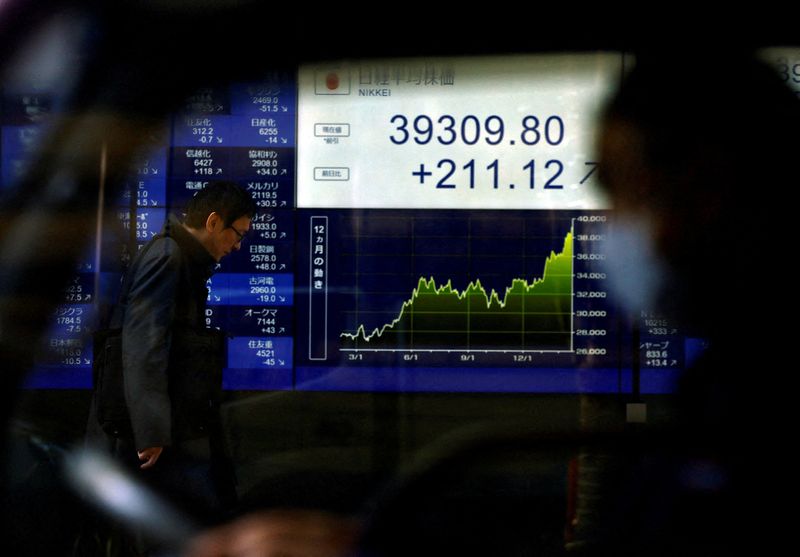© Reuters. FILE PHOTO: An electronic screen displaying Japan’s Nikkei share average and stock prices is seen through a car as the share average hits a record high in Tokyo, Japan February 26, 2024. REUTERS/Issei Kato/File Photo
By Kevin Buckland
TOKYO (Reuters) – Asian equities were mostly weaker on Thursday, while the dollar and U.S. Treasuries were largely steady ahead of crucial U.S. inflation data that could provide fresh clues on when the Federal Reserve will cut interest rates.
Chinese stocks, though, rebounded from Wednesday’s sharp decline to keep them on track for their best month since November 2022.
The yen gained as a Bank of Japan official hinted at the need to exit ultra-easy monetary stimulus.
Meanwhile, cryptocurrency bitcoin fluctuated around $61,400 following a three-day, 24% ascent that brought it to a more than two-year peak at $63,933.
Wall Street futures pointed marginally lower, following declines for all three major indexes overnight. pointed down 0.04% and Nasdaq futures fell 0.06%.
Investors are wary ahead of the release later in the day of the Fed’s preferred inflation gauge, the personal consumer expenditures (PCE) price index, after dialling back bets for a first rate cut to June. At the start of the year, wagers were on March.
Thursday also sees inflation data from German states, France and Spain, ahead of the euro area’s figures on Friday.
share average slipped 0.45% as of 0205 GMT, easing back a little further from the record peak reached on Tuesday.
South Korea’s Kospi declined 0.54%, while Taiwan and Australia benchmarks were flat.
However, mainland Chinese blue chips jumped 0.82%, recovering after a 1.27% slide in the previous session. For the month, they are up 8.3%, looking certain to snap a six-month streak of declines.
This month, state-led buying and tighter regulations have been primarily responsible for pulling the index off five-year lows, but expectations for more aggressive stimulus will need to become reality to retain the momentum amid a moribund economy, saddled with listless consumers and a teetering property market.
Next week’s annual session of the National People’s Congress, where the year’s growth target will be set, and a plan laid out for achieving it, will provide the clearest indications of the government’s stimulus efforts.
Hong Kong’s added 0.44%.
MSCI’s broadest index of Asia-Pacific shares outside Japan edged 0.06% higher.
The , which measures the currency against six major peers including the yen, euro and sterling, edged 0.06% lower to 103.86.
Most of that was driven by a dip against the yen, after BOJ board member Hajime Takata said in a speech that the central bank needs to consider “nimble and flexible responses,” including ending policies such as negative interest rates and yield curve control.
Analysts and investors have been primarily expecting the BOJ to exit negative rates in April, with a risk of a move in March.
The dollar dropped 0.52% to 149.91 yen, falling through the closely watched 150 line for the first time in more than a week.
The euro was little changed at $1.0834, and sterling was flat at $1.26635.
Benchmark were stable at around 4.28%.
was 1.5% higher at $61,477, after jumping to the cusp of $64,000 overnight for the first time since November 2021, and bringing the all-time high of $68,999.99 into sight.
“If this were any other market, it would likely be in the ‘blow-off top – don’t go near that bubble’ category, but bitcoin is back in its parabolic-rally phase, with no immediate signs of a top,” said Matt Simpson, senior market analyst at City Index.
In commodities, oil prices eased after a larger-than-expected build in stockpiles stoked worries about slow demand, while signs that U.S. interest rates could remain elevated for longer also added to pressure. [O/R]
futures fell 22 cents, or 0.3%, to $83.46 a barrel. U.S. West Texas Intermediate crude futures were down 30 cents, or 0.4%, to $78.24 a barrel.
Credit: Source link




